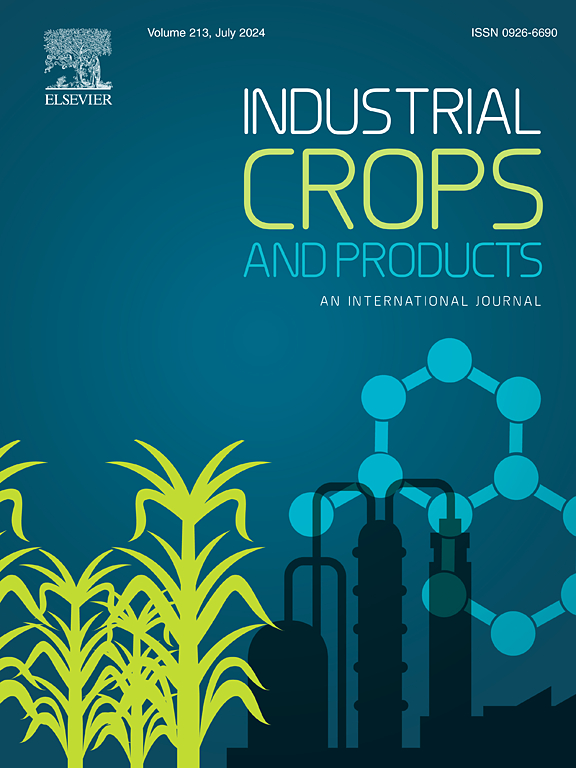花椒皮含黄酮提取物对阳离子棉织物着色和功能化的稳定性评价
IF 6.2
1区 农林科学
Q1 AGRICULTURAL ENGINEERING
引用次数: 0
摘要
研究了花椒黄酮提取物对阳离子化棉织物的可持续染色和功能化。提取液经乙醇/水萃取得到,并用大孔树脂进行纯化,其中芦丁、黄芪苷、香豆素、黄芩苷、槲皮素等黄酮类化合物占总成分的72% %以上。稳定性测试表明,zbpf在中性或轻度酸性条件下是稳定的,但对还原剂、长时间光照和金属离子高度敏感。用3-氯-2-羟丙基三甲基氯化铵改性棉织物,zbpf染色后,在5 % owf下,最大色深(K/S值)为12.5。用2 % owf zbpf染色的织物具有良好的紫外线防护(UPF为115.54),抗氧化活性(98.1% %自由基清除)和抗菌效果(对大肠杆菌和金黄色葡萄球菌的抗菌效果超过98 %)。ZBPFs在阳离子化棉花上的吸附符合拟二阶模型和Sips模型。这表明化学吸附是zbpf与织物之间的主要机制,并表明zbpf与织物之间存在多种相互作用。染色织物的摩擦牢度和洗涤牢度稳定性较高,但耐光牢度较低。此外,用硫酸铝钾洗涤显著降低了抗氧化和抗菌性能,而用其他溶液(如自来水和去离子水)洗涤对性能的影响最小。该研究强调了ZBPFs作为一种稳定、生物活性和环境友好型染料的潜力,在纺织应用中具有相当大的功能和生态效益。本文章由计算机程序翻译,如有差异,请以英文原文为准。

Stability assessments of coloration and functionalization of cationic cotton fabric using flavonoid-rich extracts from Zanthoxylum bungeanum pericarps
This study investigates the use of flavonoid-rich extracts from Zanthoxylum bungeanum pericarps (ZBPFs) for sustainable dyeing and functionalization of cationized cotton fabrics. The extracts were obtained through ethanol/water extraction and purified using macroporous resin, with flavonoids such as rutin, astragalin, coumarin, baicalin, and quercetin making up over 72 % of the total composition. Stability tests revealed that ZBPFs were stable under neutral or mildly acidic conditions but were highly sensitive to reducing agents, prolonged light exposure, and metal ions. Cotton fabrics modified with 3-chloro-2-hydroxypropyl trimethylammonium chloride and dyed with ZBPFs reached a maximum color depth (K/S value) of 12.5 at 5 % owf. Fabrics dyed with 2 % owf ZBPFs demonstrated excellent UV protection (UPF of 115.54), antioxidant activity (98.1 % radical scavenging), and antibacterial efficacy (over 98 % against E. coli and S. aureus). The adsorption of ZBPFs onto cationized cotton fitted both the pseudo-second-order and Sips models. This indicates that chemical adsorption is the predominant mechanism and suggests multiple interactions between the ZBPFs and the fabric. The dyed fabrics exhibited high stability in rubbing and washing fastness, although their light fastness was comparatively lower. Further, washing with potassium aluminum sulfate significantly diminished the antioxidant and antibacterial properties, while washing with other solutions, such as tap water and deionized water, showed minimal effects on performance. This research highlights the potential of ZBPFs as a stable, bioactive, and environmentally friendly dye, offering considerable functional and ecological benefits in textile applications.
求助全文
通过发布文献求助,成功后即可免费获取论文全文。
去求助
来源期刊

Industrial Crops and Products
农林科学-农业工程
CiteScore
9.50
自引率
8.50%
发文量
1518
审稿时长
43 days
期刊介绍:
Industrial Crops and Products is an International Journal publishing academic and industrial research on industrial (defined as non-food/non-feed) crops and products. Papers concern both crop-oriented and bio-based materials from crops-oriented research, and should be of interest to an international audience, hypothesis driven, and where comparisons are made statistics performed.
 求助内容:
求助内容: 应助结果提醒方式:
应助结果提醒方式:


